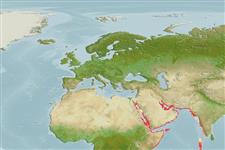Teleostei (teleosts) >
Blenniiformes (Blennies) >
Tripterygiidae (Triplefin blennies) > Tripterygiinae
Etymology: Helcogramma: Greek, helkos, -eos, -ous = ulcer, sore + Greek, gramma = letter, mark (Ref. 45335).
Eponymy: Dr Heinz Steinitz (1909–1971) was an Israeli marine biologist, ichthyologist and physician. [...] (Ref. 128868), visit book page.
Environment: milieu / climate zone / depth range / distribution range
Ecology
Marine; reef-associated; depth range 0 - 12 m (Ref. 11441). Tropical
Western Indian Ocean: Arabian Peninsula, northern Red Sea to the Persian Gulf.
Size / Weight / Age
Maturity: Lm ? range ? - ? cm
Max length : 6.0 cm SL male/unsexed; (Ref. 88983)
Dorsal spines (total): 15 - 17; Dorsal soft rays (total): 10 - 12; Anal spines: 1; Anal soft rays: 19 - 21; Vertebrae: 35 - 36. Dorsal fins III + XII-XIV + 10-12 (usually III + XIII + 10-11); anal fin I, 19-21 (usually 20); pectoral fins usually 15-17 (usually 16: 2, 7, 7). Lateral line continuous, tubed scales 21-27, ending below anterior part of third dorsal fin; total lateral scales 38-40 (37-41, from Clark). Nape, belly, and bases of first dorsal and anal fins scaleless; caudal fin with 1 or 2 rows of scales at base. Pelvic-fin rays bound together by membrane for half the length of shorter ray, longer ray reaches vent. First dorsal fin, triangular, originates over posterior margin of preopercle, in males first spine about as long as longest spine of second dorsal fin, but shorter in females; first two spines close to each other. Mouth large; maxilla reaches vertical through posterior border of pupil; orbital cirrus very small; dentary pores 3 + 1 + 3; head length 3.0-3.5 in SL (Ref. 88983).
Found usually solitary on corals and rocks in lagoons and bays from 0.5-12 m or deeper (Ref. 88983).
Life cycle and mating behavior
Maturity | Reproduction | Spawning | Eggs | Fecundity | Larvae
Holleman, W. and S.V. Bogorodsky, 2012. A review of the blennioid fish family Tripterygiidae (Perciformes) in the Red Sea, with description of Enneapterygius qirmiz, and reinstatement of Enneapterygius altipinnis Clark, 1980. Zootaxa 3152:36-60. (Ref. 88983)
IUCN Red List Status (Ref. 130435: Version 2024-1)
Threat to humans
Harmless
Human uses
Tools
Special reports
Download XML
Internet sources
Estimates based on models
Preferred temperature (Ref.
123201): 25 - 29.2, mean 27.5 °C (based on 503 cells).
Phylogenetic diversity index (Ref.
82804): PD
50 = 0.5000 [Uniqueness, from 0.5 = low to 2.0 = high].
Bayesian length-weight: a=0.00617 (0.00288 - 0.01322), b=3.04 (2.86 - 3.22), in cm total length, based on LWR estimates for this (Sub)family-body shape (Ref.
93245).
Trophic level (Ref.
69278): 3.1 ±0.3 se; based on size and trophs of closest relatives
Resilience (Ref.
120179): High, minimum population doubling time less than 15 months (Preliminary K or Fecundity.).
Fishing Vulnerability (Ref.
59153): Low vulnerability (10 of 100).
